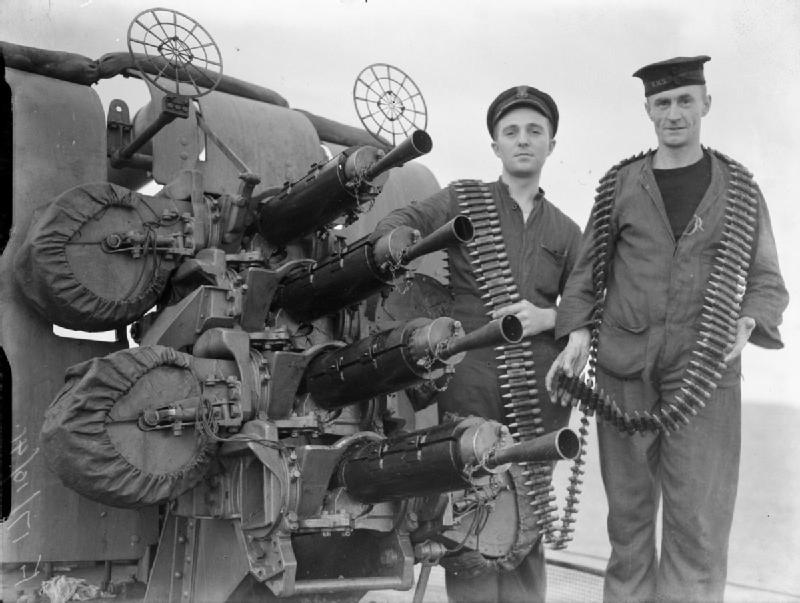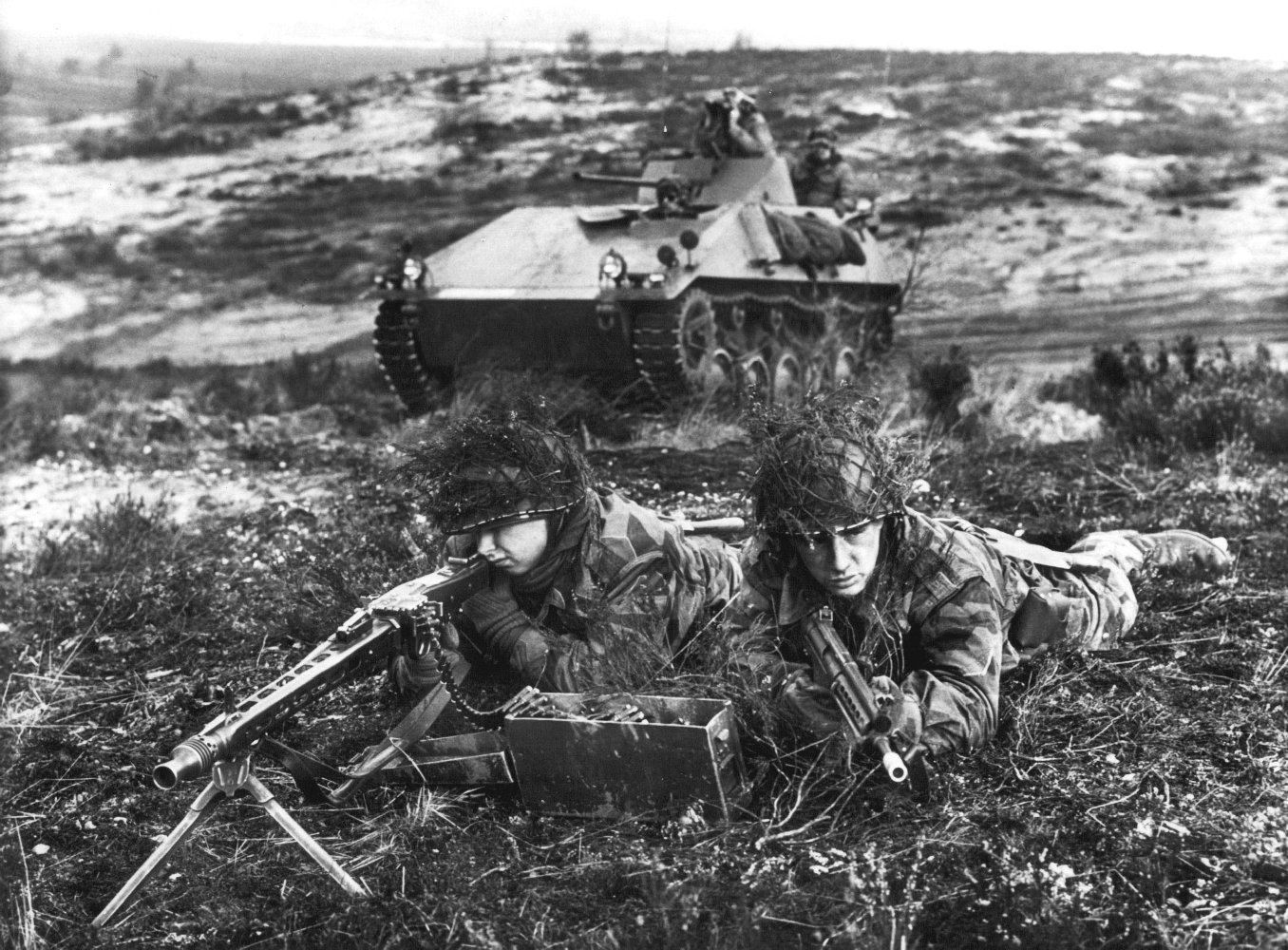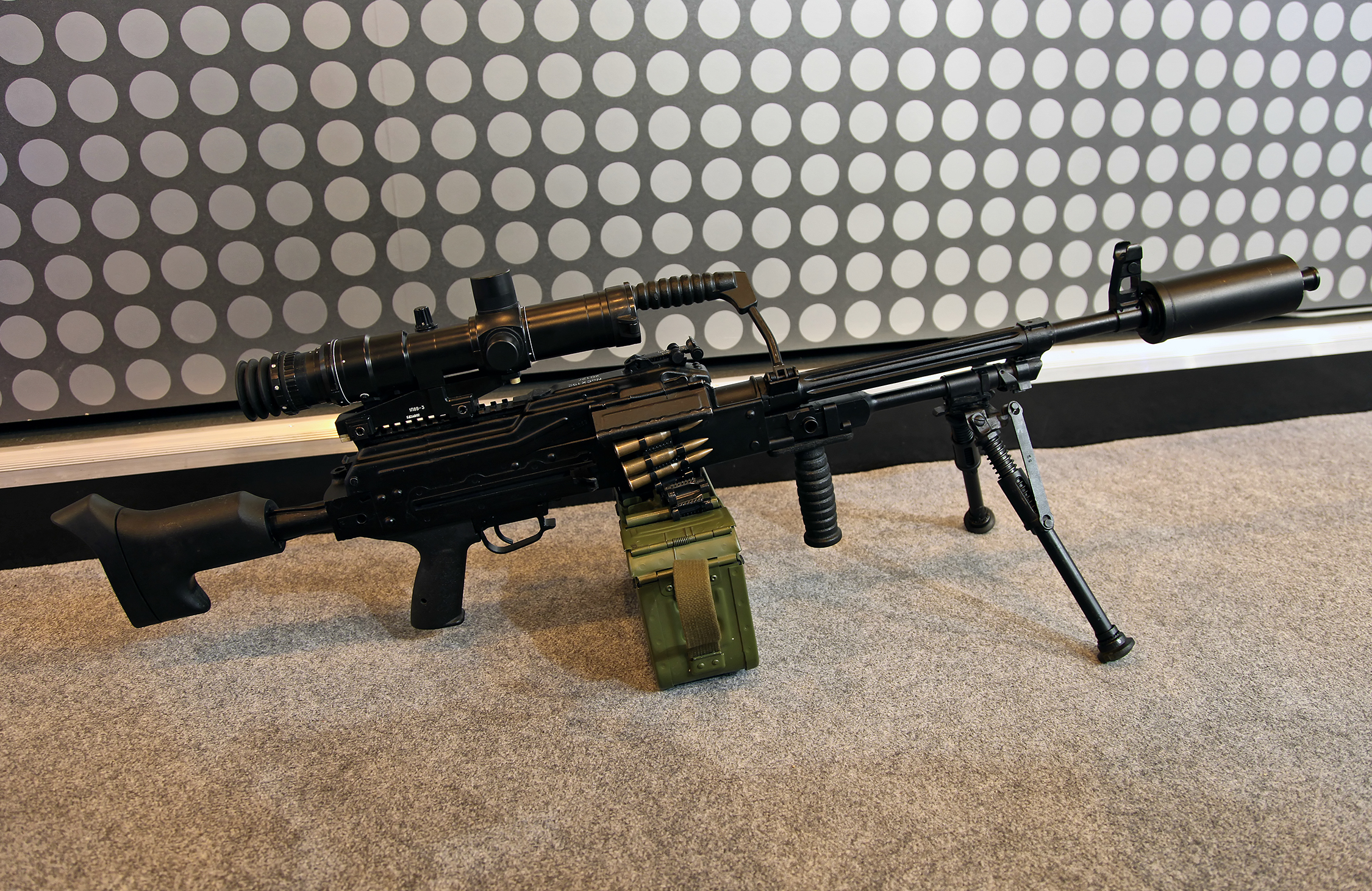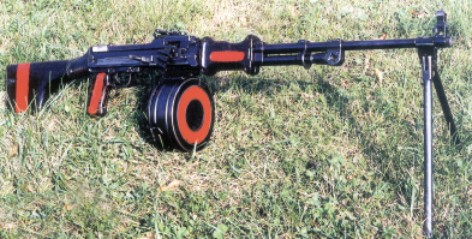|
Belt (firearm)
An ammunition belt is a firearm device used to package and feed cartridges, typically for rapid-firing automatic weapons such as machine guns. Belt-fed systems minimize the proportional weight of the ammunition apparatus to the entire weapon system, and allow high rates of continuous fire without needing frequent magazine changes. The capacity of belts and associated belt containers is typically a function of weight and bulk, and their size is limited by caliber and the combined portability of the weapon and ammunition. Typical capacities for man-portable weapon systems range from 50 to 300 rounds of ammunition. Variants Feed strip The "feed strip" (also referred to as an "ammo strip" or "feed tray") was initially designed in 1895, based on initial designs by Captain Baron Adolf Odkolek von Ujezda of Vienna, Austria. A feed strip is a simple rigid metal (usually steel or brass) tray, typically holding 15 to 30 cartridges that are crimped together into a row. The feed st ... [...More Info...] [...Related Items...] OR: [Wikipedia] [Google] [Baidu] [Amazon] |
M60closeup2002
M6, M06, M.6, or M-6 may refer to: Military * M6 bayonet, a bayonet for the M14 rifle * M6 bomb truck, a truck used to move bombs during World War II * M6 gun motor carriage, an American World War II light truck armed with an anti-tank gun * 75 mm gun M2/M3/M6, M6 gun, a 3" towed artillery piece * M6 heavy tank, a World War II heavy tank design that never entered full production * M6 Linebacker, an anti-aircraft variant of the M2 Bradley infantry fighting vehicle * M6 mine, a United States metal-cased, circular anti-tank landmine * M6 ''Mosegris'', Danish designation for C15TA Armoured Truck * M6 tractor, a high-speed artillery tractor * M6-640, a 60 mm mortar used by the British Army * Hirtenberger M6C-210 Commando, a 60 mm mortar used by various armies * LWRC M6, a series of United States military carbines based on the M4 carbine * Fokker M.6, a 1916 German two-seat experimental fighter aircraft * Macchi M.6, a 1917 Italian flying boat fighter prototype Survival gun ... [...More Info...] [...Related Items...] OR: [Wikipedia] [Google] [Baidu] [Amazon] |
Type 92 Heavy Machine Gun
is a Japanese heavy machine gun, related to the Hotchkiss machine gun series. It entered service in 1932 and was the standard Japanese heavy machine gun used during World War II. The Type 92 was similar in design to the earlier Type 3 heavy machine gun but chambered to fire the improved 7.7mm rimmed or semi-rimmed round. Known for its reliability, it was used after the war by various forces in East Asia. Designed by Kijiro Nambu and built by Hino Motors and Hitachi, its total production was about 45,000 guns. Type 92 refers to the Japanese Imperial year 2592 – 1932 in the Gregorian calendar – in which the gun entered service. Design The Type 92 was essentially a scaled-up version of the Type 3 heavy machine gun, with its calibre increased to 7.7 mm, and like the Type 3 was air cooled, ammo strip-fed, and based on the Hotchkiss M1914. It could use both a rimless and semi-rimmed 7.7×58mm Shiki round. A 7.7mm Arisaka round could be used if necessary or if other ammu ... [...More Info...] [...Related Items...] OR: [Wikipedia] [Google] [Baidu] [Amazon] |
Treeby Chain Gun
A revolver is a repeating handgun with at least one barrel and a revolving cylinder containing multiple chambers (each holding a single cartridge) for firing. Because most revolver models hold six cartridges before needing to be reloaded, revolvers are commonly called six shooters or sixguns. Due to their rotating cylinder mechanism, they may also be called wheel guns. Before firing, cocking the revolver's hammer partially rotates the cylinder, indexing one of the cylinder chambers into alignment with the barrel, allowing the bullet to be fired through the bore. By sequentially rotating through each chamber, the revolver allows the user to fire multiple times until having to reload the gun, unlike older single-shot firearms that had to be reloaded after each shot. The hammer cocking in nearly all revolvers is manually driven and can be cocked either by the user using the thumb to directly pull back the hammer (as in single-action), or via internal linkage relaying the fo ... [...More Info...] [...Related Items...] OR: [Wikipedia] [Google] [Baidu] [Amazon] |
Vickers Machine Gun
The Vickers machine gun or Vickers gun is a Water cooling, water-cooled .303 British (7.7 mm) machine gun produced by Vickers Limited, originally for the British Army. The gun was operated by a three-man crew but typically required more men to move and operate it: one fired, one fed the ammunition, the others helped to carry the weapon, its ammunition, and spare parts. It was in service from before the First World War until the 1960s, with air-cooled versions of it on many Allies of World War I, Allied World War I Aviation in World War I, fighter aircraft. The weapon had a reputation for great solidity and reliability. Ian V. Hogg, in ''Weapons & War Machines'', describes an action that took place in August 1916, during which the British 100th Company of the Machine Gun Corps fired their ten Vickers guns to deliver sustained fire for twelve hours. Using 100 barrels, they fired a million rounds without breakdowns. "It was this absolute foolproof reliability which endear ... [...More Info...] [...Related Items...] OR: [Wikipedia] [Google] [Baidu] [Amazon] |
QJY-88
The QJY-88, also known as the Type 88 LMG (), is a 5.8x42mm Chinese light machine gun designed in the late 1980s by China North Industries Corporation, otherwise known as Norinco. It was intended to replace the obsolete Type 67 machine gun in service with the PLA. Design The GPMG was created with first prototypes designed in 1989 before it was approved for production in 1999. A variant with a heavier barrel, longer flash hider, and an electric solenoid trigger that replaces the buttstock, named QJT88 (QJT5.8), is designed for vehicle coaxial usage. Variants ;QJY-88: base variant. ;QJT-88: coaxial machine gun with electric solenoid trigger Users * : Claimed to have been retired by the PLA and replaced by QJY-201. Still in use by Chinese law enforcement. Non-state actors * Tamil Tigers The Liberation Tigers of Tamil Eelam (LTTE; , ; also known as the Tamil Tigers) was a Tamil militant organization, that was based in the northern and eastern Sri Lanka. The LTTE fo ... [...More Info...] [...Related Items...] OR: [Wikipedia] [Google] [Baidu] [Amazon] |
Rheinmetall MG 3
The MG 3 is a German general-purpose machine gun chambered for the 7.62×51mm NATO cartridge. The weapon's design is derived from the World War II era MG 42 that fired the 7.92×57mm Mauser round. The MG 3 was standardized in the late 1950s and adopted into service with the newly formed ''Bundeswehr'', where it continues to serve to this day as a squad support weapon and a vehicle-mounted machine gun. The weapon and its derivatives have also been acquired by the armed forces of over 40 countries. Production rights to the machine gun were purchased by Italy (), Spain, Pakistan (as the MG 1A3), Greece, Iran, Sudan, and Turkey. History At the end of World War II the original technical drawings and data for the 7.92×57mm Mauser chambered MG 42 were captured by the Soviets. These would later be taken to Czechoslovakia and Yugoslavia. Rheinmetall had to reverse engineer the first postwar machine guns from an original MG 42 machine gun. Production of the first postwar variant of ... [...More Info...] [...Related Items...] OR: [Wikipedia] [Google] [Baidu] [Amazon] |
MG 42
The MG 42 (shortened from German: ''Maschinengewehr 42'', or "machine gun 42") is a German recoil-operated air-cooled general-purpose machine gun used extensively by the Wehrmacht and the Waffen-SS during the second half of World War II. Entering production in 1942, it was intended to supplement and replace the earlier MG 34, which was more expensive and took much longer to produce, but both weapons were produced until the end of World War II. Designed to use the standard German fully-powered 7.92×57mm Mauser rifle round and to be cheaper and easier to manufacture, the MG 42 proved to be highly reliable and easy to operate. It is most notable for its very high cyclic rate for a gun using full-power service cartridges: it averaged about 1,200 rounds per minute, compared to around 850 for the MG 34, and 450 to 600 for other common machine guns like the M1919 Browning, FM 24/29, or Bren gun. This made it extremely effective in providing suppressive fire. Its unique sound l ... [...More Info...] [...Related Items...] OR: [Wikipedia] [Google] [Baidu] [Amazon] |
MG 34
The MG 34 (shortened from German: ''Maschinengewehr 34'', or "machine gun 34") is a German recoil-operated air-cooled general-purpose machine gun, first tested in 1929, introduced in 1934, and issued to units in 1936. It introduced an entirely new concept in automatic firepower – the ''Einheitsmaschinengewehr'' (Universal machine gun) – and is generally considered the world's first general-purpose machine gun (GPMG). Both the MG 34 and MG 42 were erroneously nicknamed "Spandau" by Allied troops, a carryover from the World War I nickname for the MG 08, which was produced at the Spandau Arsenal. The versatile MG 34 was chambered for the fully-powered 7.92×57mm Mauser rifle cartridge and was arguably the most advanced machine gun in the world at the time of its deployment. The MG 34 was envisaged and well-developed to provide portable light and medium machine gun infantry cover, anti-aircraft coverage, and even sniping ability. Its combination of exceptional mobility � ... [...More Info...] [...Related Items...] OR: [Wikipedia] [Google] [Baidu] [Amazon] |
PKP Pecheneg
The PKP Pecheneg (Pulemyot Kalashnikova Pekhotny "Pecheneg", ) is a Russian 7.62×54mmR general-purpose machine gun.Popenker, Max RPKP Pecheneg machine gun It is a further development and modification of the PK machine gun (PKM). It is said to be more accurate than all its predecessors due to a heavier, removable, partially forced-air-cooled barrel with radial cooling ribs and a handle which eliminates the haze effect from hot gases and keeps the barrel cooler, making the weapon more reliable. Furthermore, the weapon is capable of having a telescopic sight or other sights mounted on it, which increases its accuracy and effective range. The GRAU index of the PKP Pecheneg is "6P41", or "6P41N" (''PKP Pecheneg-N'') when fitted with a mounting rail for a night vision sight. It is currently in use by Russian Army Spetsnaz and other troops in significant numbers. Even though it was developed mainly for infantry use, it also has been fitted to several light vehicles. Name The PKP Pec ... [...More Info...] [...Related Items...] OR: [Wikipedia] [Google] [Baidu] [Amazon] |
RPL-20
The RPL-20 (Russian: Ручной Пулемёт Ленточный, ''Ruchnoy Pulemot Lentochnyy''; English: ''Belt-fed Machine Gun'') is a light machine gun developed by Kalashnikov Concern for the Russian military. History Russian (at the time Soviet) military forces have not fielded a squad-level, intermediate caliber, belt-fed machine gun since the retirement of the RPD in the early 1960s. Official Soviet doctrine from the 1960s onward dictated that squad-level suppressive fire would be provided by the RPK, while PK machine guns would be issued at the company level to provide heavier fire. While the RPK was a simpler, lighter, easier to use weapon than the RPD it replaced, it did not always perform as well as had been hoped. The weapon's magazine feed system, light weight, and fixed barrel made it excellent for one-man operation, but also hampered its ability to provide continuous suppressive fire. As such, some squad machine gunners were equipped with PK machine gu ... [...More Info...] [...Related Items...] OR: [Wikipedia] [Google] [Baidu] [Amazon] |
PK Machine Gun
The PK (, transliterated as ''Pulemyot Kalashnikova'', or "Kalashnikov's machine gun"), is a belt-fed general-purpose machine gun, chambered for the 7.62×54mmR rimmed cartridge. The modernized and most commonly known variant, known as the PKM, features several enhancements over the original PK design. Designed in the Soviet Union and currently in production in Russia, the original PK machine gun was introduced in 1961 and the improved PKM variant was introduced in 1969. The PKM was designed to replace the SGM and RP-46 machine guns that were previously in Soviet service. The weapon remains in use as a front-line infantry and vehicle-mounted weapon with Russia's armed forces and has also been exported extensively and produced in several other countries under license. History The Main Artillery Directorate of the Soviet Union (GRAU) adopted specification requirements for a new 7.62 mm general-purpose company and battalion-level machine gun that was to be chambered for ... [...More Info...] [...Related Items...] OR: [Wikipedia] [Google] [Baidu] [Amazon] |
RPD Machine Gun
The RPD (, English: Degtyaryov hand-held machine gun) is a 7.62x39mm light machine gun developed in the Soviet Union by Vasily Degtyaryov for the 7.62×39mm M43 intermediate cartridge. It was created as a replacement for the DP machine gun chambered for the 7.62×54mmR round. It is a precursor of most squad automatic weapons.Woźniak, Ryszard: ''Encyklopedia najnowszej broni palnej—tom 4 R–Z'', page 32. Bellona, 2002. It was succeeded in Soviet service by the RPK. History Work on the weapon commenced in 1943. Three prominent Soviet engineers were asked to submit their own designs: Vasily Degtyaryov, Sergei Simonov and Alexei Sudayev. Among the completed prototypes prepared for evaluation, the Degtyaryov design proved superior and was accepted into service with the Soviet armed forces as the 7.62 mm Ручной Пулемёт Дегтярёва, PПД (RPD, ''Ruchnoy Pulemyot Degtyaryova'' or "Degtyaryov light machine gun") model 1944. Although the R ... [...More Info...] [...Related Items...] OR: [Wikipedia] [Google] [Baidu] [Amazon] |









